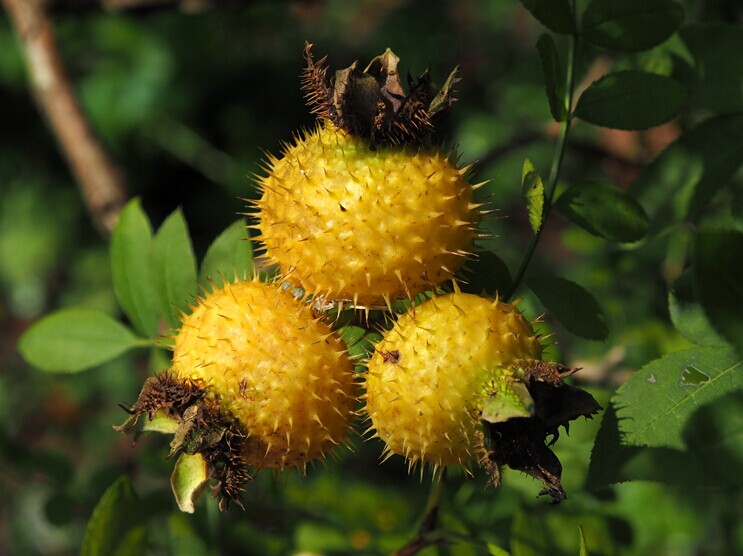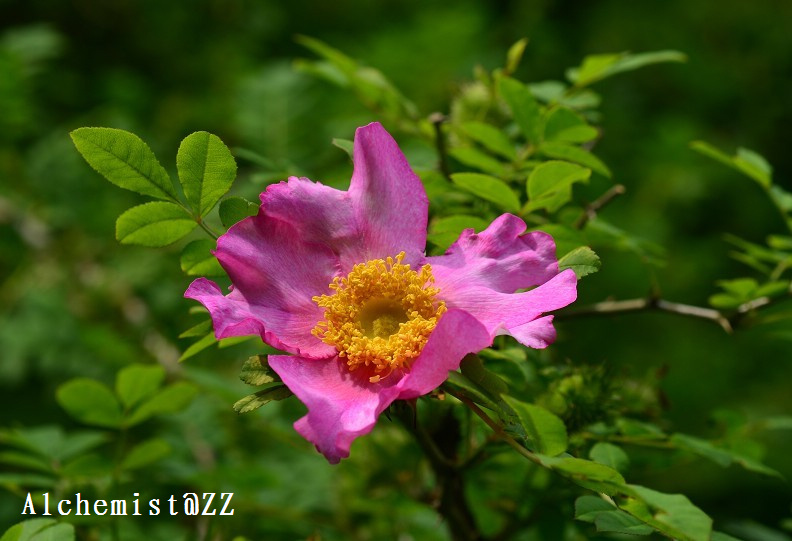缫丝花 Rosa roxburghii
- Scientific Name: Rosa roxburghii Tratt.
- Ref: Rosac. Monogr. 2:233. 1823
- Synonyms: Juzepczukia roxburghii (Tratt.) Chrshan., Platyrhodon microphyllum Hurst, Saintpierrea microphylla Germ.
- English Common Name: chestnut rose, burr rose
- Chinese Common Name: 缫丝花 sāosī∙huā, 刺䕷/刺蘼 cìmí
- Japanese Common Name: イザヨイバラ [十六夜薔薇] izayoibara, トゲナシ [刺梨] togenashi
- Family: Rosaceae
- Genus: Rosa
- Distribution: Mountain forests, thickets, slopes, stream sides, also cultivated; 500–1400 m. Anhui, Fujian, S Gansu, Guangxi, Guizhou, Hubei, Hunan, Jiangxi, S Shaanxi, Sichuan, Xizang, Yunnan, Zhejiang [Japan].
- Photo: 05/02/2013
Shrubs diffuse, 1–2.5 m tall. Bark gray-brown; branchlets ascending-spreading, purple-brown, terete; prickles paired at nodes, mostly straight, to 5 mm, somewhat flat, abruptly narrowing to broad base. Leaves including petiole 5–11 cm; stipules mostly adnate to petiole, free parts subulate, margin glandular-pubescent; rachis and petioles with scattered small prickles; leaflets 9–15, elliptic or oblong, rarely obovate, 1–2 × 0.6–1.2 cm, glabrous, abaxially with prominent veins, conspicuously reticulate, base broadly cuneate, margin acutely simply serrulate, apex acute or rounded-obtuse. Flowers solitary, or 2 or 3 and fasciculate apically on branches, 4–6 cm in diam.; pedicel short; bracts 2 or 3, small, margin glandular-pubescent. Hypanthium depressed-globose, densely bristly. Sepals 5, usually broadly ovate, abaxially densely prickly, adaxially tomentose, pinnately lobed, apex acuminate. Petals 5, slightly fragrant, pink to rose-purple or reddish, obovate. Carpels on projected torus at base of hypanthium; styles free, not exserted, shorter than stamens, pubescent. Hip green-red, depressed-globose, 1.5–2 cm in diam., densely prickly, with persistent, erect sepals. Fl. Mar–Jul, fr. Aug–Oct. (Flora of China)

08/21/2014, Hangzhou Botanical Garden
